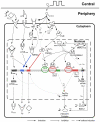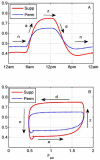Circadian characteristics of permissive and suppressive effects of cortisol and their role in homeostasis and the acute inflammatory response
- PMID: 25445574
- PMCID: PMC4306649
- DOI: 10.1016/j.mbs.2014.10.006
Circadian characteristics of permissive and suppressive effects of cortisol and their role in homeostasis and the acute inflammatory response
Abstract
In this work we explore a semi-mechanistic model that considers cortisol's permissive and suppressive effects through the regulation of cytokine receptors and cytokines respectively. Our model reveals the proactive role of cortisol during the resting period and its reactive character during the body's activity phase. Administration of an acute LPS dose during the night, when cortisol's permissive effects are higher than suppressive, leads to increased cytokine levels compared to LPS administration at morning when cortisol's suppressive effects are higher. Interestingly, our model presents a hysteretic behavior where the relative predominance of permissive or suppressive effects results not only from cortisol levels but also from the previous states of the model. Therefore, for the same cortisol levels, administration of an inflammatory stimulus at cortisol's ascending phase, that follows a time period where cytokine receptor expression is elevated ultimately sensitizing the body for the impending stimulus, leads to higher cytokine expression compared to administration of the same stimulus at cortisol's descending phase.
Keywords: Cortisol permissive effects; Cortisol suppressive effects; Cytokine circadian rhythms; Inflammatory response.
Copyright © 2014 Elsevier Inc. All rights reserved.
Figures




Similar articles
-
Mathematical modeling of light-mediated HPA axis activity and downstream implications on the entrainment of peripheral clock genes.Physiol Genomics. 2014 Oct 15;46(20):766-78. doi: 10.1152/physiolgenomics.00026.2014. Epub 2014 Jul 29. Physiol Genomics. 2014. PMID: 25073602
-
Cortisol's effects on human mental functioning.J Clin Psychopharmacol. 1982 Apr;2(2):91-101. J Clin Psychopharmacol. 1982. PMID: 7042773 Review.
-
Endogenous cortisol determines the circadian rhythm of lipopolysaccharide-- but not lipoteichoic acid--inducible cytokine release.Eur J Immunol. 2006 Feb;36(2):371-9. doi: 10.1002/eji.200535470. Eur J Immunol. 2006. PMID: 16453387
-
A phenomenological model for circadian and sleep allostatic modulation of plasma cortisol concentration.Am J Physiol Endocrinol Metab. 2012 Nov 15;303(10):E1190-201. doi: 10.1152/ajpendo.00271.2012. Epub 2012 Sep 25. Am J Physiol Endocrinol Metab. 2012. PMID: 23011061
-
Circadian rhythms: glucocorticoids and arthritis.Ann N Y Acad Sci. 2006 Jun;1069:289-99. doi: 10.1196/annals.1351.027. Ann N Y Acad Sci. 2006. PMID: 16855156 Review.
Cited by
-
Mathematical modeling of mammalian circadian clocks affecting drug and disease responses.J Pharmacokinet Pharmacodyn. 2021 Jun;48(3):375-386. doi: 10.1007/s10928-021-09746-z. Epub 2021 Mar 16. J Pharmacokinet Pharmacodyn. 2021. PMID: 33725238 Free PMC article. Review.
-
A Circadian Rhythm in both Complement Cascade (ComC) Activation and Sphingosine-1-Phosphate (S1P) Levels in Human Peripheral Blood Supports a Role for the ComC-S1P Axis in Circadian Changes in the Number of Stem Cells Circulating in Peripheral Blood.Stem Cell Rev Rep. 2018 Oct;14(5):677-685. doi: 10.1007/s12015-018-9836-7. Stem Cell Rev Rep. 2018. PMID: 29911288 Free PMC article.
-
Understanding Physiology in the Continuum: Integration of Information from Multiple -Omics Levels.Front Pharmacol. 2017 Feb 27;8:91. doi: 10.3389/fphar.2017.00091. eCollection 2017. Front Pharmacol. 2017. PMID: 28289389 Free PMC article.
-
Asymmetry in Signal Oscillations Contributes to Efficiency of Periodic Systems.Crit Rev Biomed Eng. 2016;44(3):193-211. doi: 10.1615/CritRevBiomedEng.2017019658. Crit Rev Biomed Eng. 2016. PMID: 28605352 Free PMC article.
-
Sleep disorders and health-related quality of life in patients with interstitial lung disease.Sleep Breath. 2018 May;22(2):393-400. doi: 10.1007/s11325-017-1579-1. Epub 2017 Oct 16. Sleep Breath. 2018. PMID: 29038949
References
-
- Hotchkiss RS, Karl IE. The pathophysiology and treatment of sepsis. N Engl J Med. 2003;348(2):138–50. - PubMed
-
- Chrousos GP. Stress and disorders of the stress system. Nat Rev Endocrinol. 2009;5(7):374–81. - PubMed
-
- Tsigos C, Chrousos GP. Physiology of the hypothalamic-pituitary-adrenal axis in health and dysregulation in psychiatric and autoimmune disorders. Endocrinol Metab Clin North Am. 1994;23(3):451–66. - PubMed
-
- Barnes PJ. Anti-inflammatory actions of glucocorticoids: molecular mechanisms. Clin Sci (Lond) 1998;94(6):557–72. - PubMed
-
- Tracey KJ, et al. Shock and tissue injury induced by recombinant human cachectin. Science. 1986;234(4775):470–4. - PubMed
Publication types
MeSH terms
Substances
Grants and funding
LinkOut - more resources
Full Text Sources
Other Literature Sources

